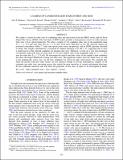| dc.contributor.author | Kimball, Amy E. | |
| dc.contributor.author | Knapp, Gillian R. | |
| dc.contributor.author | Ivezic, Zeljko | |
| dc.contributor.author | Bochanski, John J. | |
| dc.contributor.author | Plotkin, Richard M. | |
| dc.contributor.author | Gordon, Michael S. | |
| dc.contributor.author | West, A. A. | |
| dc.date.accessioned | 2015-03-06T20:41:48Z | |
| dc.date.available | 2015-03-06T20:41:48Z | |
| dc.date.issued | 2009-08 | |
| dc.date.submitted | 2009-01 | |
| dc.identifier.issn | 0004-637X | |
| dc.identifier.issn | 1538-4357 | |
| dc.identifier.uri | http://hdl.handle.net/1721.1/95918 | |
| dc.description.abstract | We conduct a search for radio stars by combining radio and optical data from the FIRST survey and the Sloan Digital Sky Survey (SDSS). The faint limit of SDSS makes possible a homogeneous search for radio emission from stars of low optical luminosity. We select a sample of 112 candidate radio stars in the magnitude range 15 < i lsim 19.1 and with radio flux S 20 ≥ 1.25 mJy, from about 7000 deg2 of sky. The selection criteria are positional coincidence within 1'', radio and optical point source morphology, and an SDSS spectrum classified as stellar. The sample contamination is estimated by random matching to be 108 ± 13, suggesting that at most a small fraction of the selected candidates are genuine radio stars. Therefore, we rule out a very rare population of extremely radio-loud stars: no more than 1.2 of every million stars in the magnitude range 15 < i < 19.1 stars has radio flux S [subscript 20] ≥ 1.25 mJy. We investigate the optical and radio colors of the sample to find candidates that show the largest likelihood of being real radio stars. The significant outliers from the stellar locus, as well as the magnetically active stars, are the best candidates for follow-up radio observations. We conclude that, while the present wide-area radio surveys are not sensitive enough to provide homogeneous samples of the extremely rare radio stars, upcoming surveys that exploit the great sensitivity of current and planned telescopes do have sufficient sensitivity and will allow the properties of this class of object to be investigated in detail. | en_US |
| dc.description.sponsorship | National Science Foundation (U.S.) (NSF grant AST-0507259) | en_US |
| dc.description.sponsorship | National Science Foundation (U.S.) (NSF Graduate Research Fellowship) | en_US |
| dc.description.sponsorship | Princeton University. Department of Astrophysical Sciences (Advisory Council Summer Studen Fellowship) | en_US |
| dc.description.sponsorship | Alfred P. Sloan Foundation | en_US |
| dc.description.sponsorship | United States. Dept. of Energy | en_US |
| dc.description.sponsorship | United States. National Aeronautics and Space Administration | en_US |
| dc.language.iso | en_US | |
| dc.publisher | Institute of Physics/American Astronomical Society | en_US |
| dc.relation.isversionof | http://dx.doi.org/10.1088/0004-637x/701/1/535 | en_US |
| dc.rights | Article is made available in accordance with the publisher's policy and may be subject to US copyright law. Please refer to the publisher's site for terms of use. | en_US |
| dc.source | American Astronomical Society | en_US |
| dc.title | A SAMPLE OF CANDIDATE RADIO STARS IN FIRST AND SDSS | en_US |
| dc.type | Article | en_US |
| dc.identifier.citation | Kimball, Amy E., Gillian R. Knapp, Zeljko Ivezic, Andrew A. West, John J. Bochanski, Richard M. Plotkin, and Michael S. Gordon. “A SAMPLE OF CANDIDATE RADIO STARS IN FIRST AND SDSS.” The Astrophysical Journal 701, no. 1 (July 24, 2009): 535–546.© 2009 American Astronomical Society. | en_US |
| dc.contributor.department | MIT Kavli Institute for Astrophysics and Space Research | en_US |
| dc.contributor.mitauthor | West, Andrew A. | en_US |
| dc.contributor.mitauthor | Bochanski, John J. | en_US |
| dc.relation.journal | Astrophysical Journal | en_US |
| dc.eprint.version | Final published version | en_US |
| dc.type.uri | http://purl.org/eprint/type/JournalArticle | en_US |
| eprint.status | http://purl.org/eprint/status/PeerReviewed | en_US |
| dspace.orderedauthors | Kimball, Amy E.; Knapp, Gillian R.; Ivezić, Željko; West, Andrew A.; Bochanski, John J.; Plotkin, Richard M.; Gordon, Michael S. | en_US |
| mit.license | PUBLISHER_POLICY | en_US |
| mit.metadata.status | Complete | |
